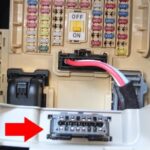If you’ve ever wondered, “What Year Was Obd2 Introduced?”, you’re not alone. The terms OBD and OBDII are frequently mentioned in discussions about modern vehicles, vehicle diagnostics, and connected car technologies. Understanding the history and evolution of these systems is key to appreciating their vital role in today’s automotive landscape. This article will explore the journey of on-board diagnostics, pinpoint the year OBD2 was introduced, and delve into why this technology is so crucial.
What is OBD and Why is it Important?
OBD stands for On-Board Diagnostics. In essence, it’s the self-diagnostic system within your vehicle’s electronics. Think of it as your car’s internal health monitoring system, providing vehicle self-diagnosis and reporting capabilities that are invaluable for repair technicians. An OBD system grants technicians access to a wealth of subsystem information, allowing them to effectively monitor performance and accurately analyze repair needs.
OBD has become the standardized protocol across the majority of light-duty vehicles for accessing this crucial diagnostic data. This information is generated by the engine control units (ECUs), also known as engine control modules, which act as the vehicle’s central processing units or computers. These ECUs constantly monitor various aspects of the vehicle’s operation and report any anomalies or issues.
 Diagram showing where the OBDII is located inside a vehicle
Diagram showing where the OBDII is located inside a vehicle
The Significance of OBD in Modern Automotive Technology
OBD’s importance extends far beyond just repair shops. It’s a cornerstone of modern telematics and fleet management. By providing detailed insights into vehicle health and driving behavior, OBD data empowers fleet managers and vehicle owners alike to make informed decisions.
Thanks to OBD, fleets can achieve significant improvements in efficiency and maintenance, including:
- Tracking Wear Trends: Identify patterns in vehicle component wear, allowing for proactive maintenance scheduling and preventing costly breakdowns.
- Proactive Diagnostics: Instantly diagnose potential vehicle problems before they escalate, shifting from reactive repairs to proactive management strategies.
- Driving Behavior Monitoring: Measure and analyze driving habits, including speed, idling time, and harsh braking, promoting safer and more fuel-efficient driving.
From OBD to OBDII: The Dawn of Standardization
While the original OBD systems laid the groundwork, they were far from standardized. This lack of uniformity presented significant challenges. The first generation OBD, often referred to as OBD-I, was often external to the car’s main computer system. Different manufacturers employed their own proprietary systems, meaning diagnostic tools and connectors were not universally compatible. Imagine a mechanic needing a unique scanner for each car brand – that was the reality before standardization.
OBDII emerged as the second generation, designed to address these limitations. The crucial difference lies in standardization and integration. OBDII systems are integrated directly into the vehicle’s computer network and adhere to industry-wide standards. The original OBD systems were prevalent until the early 1990s when OBDII began to take shape, driven by the need for greater consistency and effectiveness in vehicle diagnostics, particularly in relation to growing concerns about vehicle emissions.
Unveiling the Introduction Year: The History of OBDII
The journey to standardized on-board diagnostics began in the 1960s, with various organizations playing pivotal roles in shaping the standards we know today. Key players include the California Air Resources Board (CARB), the Society of Automotive Engineers (SAE), the International Organization for Standardization (ISO), and the Environmental Protection Agency (EPA).
Let’s trace the key milestones in OBD history that led to the introduction of OBD2 and finally answer the question: “what year was OBD2 introduced?”
- 1968: Volkswagen takes the first step, introducing the first OBD computer system equipped with scanning capabilities.
- 1978: Datsun follows suit, implementing a basic OBD system, albeit with limited and non-standardized features.
- 1979: The Society of Automotive Engineers (SAE) recognizes the need for uniformity and recommends a standardized diagnostic connector and a set of diagnostic test signals.
- 1980: General Motors (GM) develops a proprietary interface and protocol, enabling engine diagnostics through an RS-232 interface or, more simply, by flashing the Check Engine Light.
- 1988: Standardization efforts gain momentum. The 1988 SAE recommendation for a standard connector and diagnostics marks a turning point.
- 1991: The state of California mandates basic on-board diagnostics for all vehicles sold in the state. This early form of mandated diagnostics is retrospectively known as OBD I.
- 1994: California takes a decisive step towards comprehensive emissions testing, mandating OBD as recommended by SAE for all vehicles sold in the state starting in 1996. This enhanced and standardized system is what we now recognize as OBDII. It included standardized diagnostic trouble codes (DTCs), a significant leap forward.
- 1996: This is the pivotal year! OBD-II becomes mandatory for all cars manufactured and sold in the United States. Therefore, OBD2 was introduced in 1996 as a mandated standard in the US.
- 2001: Europe follows suit, with EOBD (the European version of OBD) becoming mandatory for all gasoline vehicles in the European Union (EU).
- 2003: EOBD expands to include all diesel vehicles in the EU.
- 2008: Further refinement in the US: all vehicles are required to implement OBDII through a Controller Area Network (CAN), as specified by ISO 15765-4, enhancing communication speed and reliability.
So, to definitively answer the question, OBD2 was introduced in 1996 as a mandatory standard for all vehicles sold in the United States, marking a significant advancement in automotive diagnostics.
Accessing Vehicle Data: What Information Does OBDII Provide?
The OBDII system offers access to a wealth of valuable data, primarily focusing on:
- Powertrain: Detailed information about the engine and transmission systems, including performance metrics and potential issues.
- Emission Control Systems: Crucial data related to the vehicle’s emissions performance, ensuring compliance and identifying potential pollution-related malfunctions.
Beyond these core areas, OBDII also provides access to essential vehicle identification and configuration information, such as:
- Vehicle Identification Number (VIN): A unique identifier for each vehicle.
- Calibration Identification Number: Software and calibration details for various vehicle systems.
- Ignition Counter: Tracks the number of ignition cycles.
- Emissions Control System Counters: Monitors the performance and usage of emission control components.
 A man extracting vehicle data from an OBDII port
A man extracting vehicle data from an OBDII port
When you take your car to a mechanic, they connect a scanning tool to the OBDII port. This tool reads trouble codes, allowing mechanics to quickly and accurately diagnose problems. This capability streamlines the repair process, enabling faster inspections and efficient fixes before minor issues become major, expensive problems.
Examples of OBDII Data:
OBDII data is organized into “modes,” each providing specific types of information. Here are a few examples:
-
Mode 1 (Vehicle Information):
- Pid 12 — Engine RPM (Revolutions Per Minute)
- Pid 13 — Vehicle Speed
-
Mode 3 (Trouble Codes): These codes indicate specific faults. The first character denotes the system affected:
- P = Powertrain (Engine and transmission)
- C = Chassis (Braking, steering, suspension)
- B = Body (Interior, airbags, comfort systems)
- U = Network (Communication systems)
Examples of Trouble Codes:
- P0201 — Injector circuit malfunction – Cylinder 1
- P0217 — Engine over temperature condition
- P0219 — Engine overspeed condition
- C0128 — Low brake fluid circuit
- C0710 — Steering position malfunction
- B1671 — Battery Module Voltage Out Of Range
- U2021 — Invalid/ fault data received
For a more comprehensive list of diagnostic trouble codes, resources like this list of standard diagnostic trouble codes are invaluable.
OBDII and the Rise of Telematics
The standardization of OBDII paved the way for the widespread adoption of telematics in vehicles. Telematics devices leverage the OBDII port to silently gather a wealth of vehicle data, including engine revolutions, vehicle speed, fault codes, and fuel consumption.
Telematics systems then process this data to provide valuable insights into:
- Trip start and finish times
- Instances of over-revving
- Speeding events
- Excessive idling
- Fuel consumption patterns
This information is then transmitted to a software interface, empowering fleet managers to effectively monitor vehicle usage, driver behavior, and overall fleet performance.
Geotab stands out in the telematics field by offering solutions that overcome the challenges of diverse OBD protocols. Their technology is designed to translate vehicle diagnostic codes from a wide range of makes and models, including electric vehicles, ensuring compatibility and data accuracy across diverse fleets.
WWH-OBD: Expanding the Horizons of Vehicle Diagnostics
Looking beyond OBDII, the automotive industry is evolving towards even more sophisticated diagnostic standards like WWH-OBD (World Wide Harmonized on-board diagnostics). WWH-OBD is an international standard promoted by the United Nations as part of the Global Technical Regulations (GTR) mandate. It aims to further standardize and enhance vehicle data monitoring, particularly for emissions and engine fault codes, on a global scale.
Advantages of WWH-OBD:
- Access to More Data Types: OBDII Mode 1 PIDs (Parameter IDs) are limited to one byte, restricting the number of unique data types to 255. WWH-OBD expands this, allowing for a greater variety of data points and future expansion.
- More Detailed Fault Data: WWH-OBD, using Unified Diagnostic Services (UDS), expands the traditional two-byte DTCs to three bytes. This additional byte provides a “failure mode,” offering much richer information about the nature and severity of faults. For example, instead of multiple codes for different ambient air temperature sensor faults, WWH-OBD consolidates them under a single code with distinct failure mode indicators. This provides mechanics with more precise diagnostic information.
Geotab is already at the forefront, supporting the WWH-OBD protocol in their firmware. Their advanced protocol detection system intelligently identifies whether a vehicle utilizes OBDII or WWH-OBD (or both) to ensure seamless data acquisition and interpretation. Geotab continuously updates its firmware to incorporate the latest advancements in diagnostic protocols, ensuring customers benefit from the richest and most accurate vehicle data available.
Conclusion: The Enduring Legacy of OBD and OBDII
In our increasingly connected world, the OBD port remains a vital artery for vehicle health, safety, and sustainability. Despite the proliferation of connected devices for vehicles, OBD and its standardized evolution to OBDII continue to provide a consistent and reliable foundation for vehicle diagnostics and data access.
While the landscape of vehicle connectivity expands, the principles of standardized diagnostics pioneered by OBDII remain essential. As telematics solutions continue to evolve, the ability to effectively interpret and translate the diverse array of vehicle diagnostic codes, as Geotab does, will be crucial for unlocking the full potential of connected vehicle data.
To delve deeper into selecting the right GPS vehicle tracking device, explore resources like “Not All OBD Plug-In Fleet Management Devices Are Made Equal.” And to understand the critical importance of cybersecurity in connected vehicle technology, consider reading “15 security recommendations” to ensure the safety and security of your vehicle data and systems.

